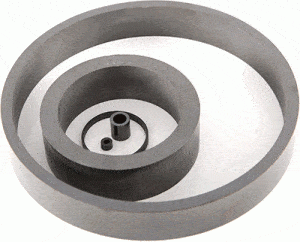Magnet Manufacturing
Bunting Magnetics Europe has been manufacturing BREMAG compression bonded magnets since the late 1980’s. In 1992, a second manufacturing facility was set up in the USA, which now offers both compression and injection moulded NdFeB magnets, including BREMAG. In this time we have gained a huge amount of experience in the manufacturing process, which together with our other core capabilities of magnetic design, magnetisation and assembly, means that Bunting Magnetics is able to offer a complete solution to customers.
Plastic bonded permanent magnets consist of a hard magnetic powder incorporated in a non-magnetic binder, usually a polymer.
The primary technique for producing stable NdFeB powder suitable for bonding, is by the rapid solidification or melt spinning route developed by General Motors in 1983.
The isotropic ribbon which is extremely stable with regard to oxidation is subsequently crushed to produce a magnetic powder suitable for bonding. This process has been subject to a number of patents since its discovery in 1983 such that there is still only one significant manufacturer of the melt spun powder. Bunting Magnetics Europe, are able to carry out additional processing steps such as additional milling stages to the powder to produce a narrower sieve fraction for improved magnet density and a better surface finish of the final magnet.
Currently there are a wide range of commercial grades of the isotropic powder that magnet manufacturers can utilise when making bonded magnets as seen by the graph. As is the case with sintered NdFeB, the higher temperature and high coercivity grades have a lower remanence than the standard grades. A low maximum operating temperature is one property that has often been associated with bonded magnets, but this is no longer the case as powder manufacturers have developed powders capable of operating up to 180°C and still with linear 2nd quadrant characteristics, which are particularly suitable for automotive applications. However, there are also other grades more suitable for injection moulding, or where very high density is required. Bunting Magnetics long experience in manufacturing means that the best powder will always be selected for customer’s applications.
Following pressing process, the component is cured at elevated temperatures and then when necessary, coated using a suitable coating depending on the customers application. Typical coatings offered, range from simple spray lacquers, epoxy spray paints or parylene coatings. Bunting Magnetics are also happy to consider using customers own coating specifications if required.
Compression moulding offers excellent off tool tolerances, 0.1mm being readily achievable in volume production. Tooling is relatively low cost and production rates can be as high as several thousand parts per hour using multi-cavity tooling. Although complex geometries can be produced, shaping is limited to geometries that can be ejected from the die. Nevertheless, bonded magnet assemblies can be produced by inserting shafts, shells or other components into the die before filling.
Magnetisation
As with all magnet materials, the final step in the manufacturing process of BREMAG magnets is magnetisation.
Bunting Magnetics Europe manufactures all its own magnetising equipment, both for in house production of magnets and also for customers own production lines. The advantage of this is not only in the ability to control the magnetisation process accurately, but means we can develop magnetising tooling for more complex magnetisation patterns such as multi-pole, Halbach or post assembly magnetisation. Often prototype magnetising tools for magnetising samples can be built relatively quickly and then these can be developed into full production tools once customer approval has been obtained.
From a production point of view, the most desirable approach is often post assembly magnetisation of the assembled device as it removes the issues of handling high energy magnetised parts during assembly of a component. However, post assembly multi-pole magnetisation is by far the most onerous of the different stages at which magnetisation can take place, so it is important to consider these options in the early stages of a product design. As will be discussed in the next section, BREMAG magnets are particularly suited to this approach and Bunting Magnetics Europe has considerable experience in this area.
